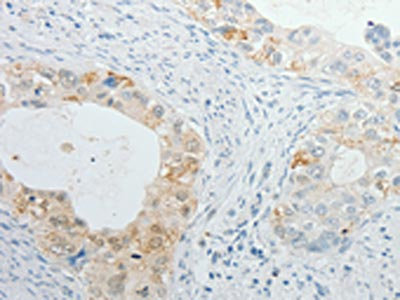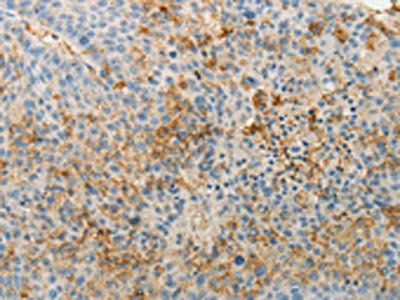
The image on the left is immunohistochemistry of paraffin-embedded Human cervical cancer tissue using CSB-PA827458(TIMP1 Antibody) at dilution 1/15, on the right is treated with fusion protein. (Original magnification: X200)
TIMP1 Antibody

CSB-PA827458
ApplicationsELISA, ImmunoHistoChemistry
Product group Antibodies
ReactivityHuman
TargetTIMP1
Overview
- SupplierCusabio
- Product NameTIMP1 Antibody
- Delivery Days Customer20
- ApplicationsELISA, ImmunoHistoChemistry
- CertificationResearch Use Only
- ClonalityPolyclonal
- ConjugateUnconjugated
- FormulationLiquid
- Gene ID7076
- Target nameTIMP1
- Target descriptionTIMP metallopeptidase inhibitor 1
- Target synonymsCLGI; collagenase inhibitor; EPA; epididymis secretory sperm binding protein; EPO; erythroid potentiating activity; fibroblast collagenase inhibitor; HCI; metalloproteinase inhibitor 1; TIMP; TIMP-1; tissue inhibitor of metalloproteinases 1
- HostRabbit
- IsotypeIgG
- Protein IDP01033
- Protein NameMetalloproteinase inhibitor 1
- Scientific DescriptionThis gene belongs to the TIMP gene family. The proteins encoded by this gene family are natural inhibitors of the matrix metalloproteinases (MMPs), a group of peptidases involved in degradation of the extracellular matrix. In addition to its inhibitory role against most of the known MMPs, the encoded protein is able to promote cell proliferation in a wide range of cell types, and may also have an anti-apoptotic function. Transcription of this gene is highly inducible in response to many cytokines and hormones. In addition, the expression from some but not all inactive X chromosomes suggests that this gene inactivation is polymorphic in human females. This gene is located within intron 6 of the synapsin I gene and is transcribed in the opposite direction.
- ReactivityHuman
- Storage Instruction-20°C or -80°C
- UNSPSC12352203

